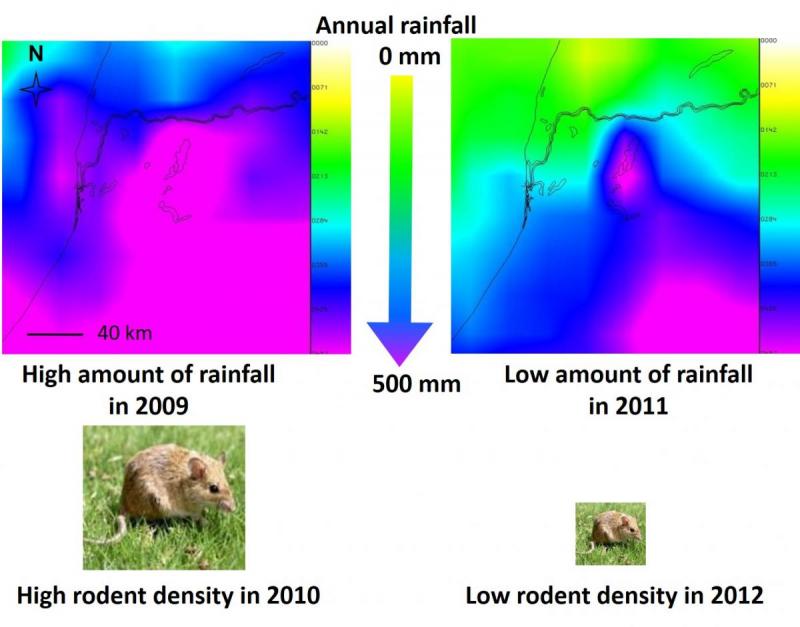Ambroise DALECKY, Jean-François MAUFFREY, Laura MARCH & Isabelle Laffont-Schwob (LPED, Marseille, France)
Cheikh Tidiane NIANG (LPED, Marseille, France & LaBAM, UGB, Saint-Louis, Senegal)
Amadou Bocar BAL (LaBAM, UGB, Saint-Louis, Senegal)
Alexis RIBAS (Laboratory of Parasitology, UB, Barcelona, Spain)
Carine BROUAT & Caroline TATARD (CBGP, Montpellier, France)
Youssoupha NIANG, Nathalie SARR & Mamadou KANE (CBGP, Dakar, Senegal)
Cheikh Moustapha DIA (LPED, Dakar, Senegal)
Stéphane RANQUE (VITROME, Marseille, France)
Vincent MORON (CEREGE, Marseille, France)
Christophe DIAGNE (ESE, Orsay, France)
Animal populations may act as reservoirs of zoonoses or as pests of crops and stored food. The arid regions of Sahel have undergone major environmental modifications due to the combined effects of human activities and physical forcing (including climate change) acting as major drivers of global environmental change.
During the last decades, a decrease in the abundance and predictability of rainfall has resulted in an aridification of Sahelian habitats. Concurrently, several waves of establishment and extension of irrigated schemes for the agriculture have modified land use. Northern Senegal is particularly impacted by climate and agricultural changes and we expect that these changes are accompanied by an increase in food and water resources around which human populations, livestock, rodents and their parasites concentrate and meet, with growing risks of pathogen amplification and transmission.
This project focuses on studying variations in structure and abundance of rodent communities and of their parasites in relation to rainfall variations and to changes in land use and practice along the valley of River Senegal (data from the ObsMiCE international observatory).
In the lowlands of River Senegal, we sampled 5 species of rodents: Arvicanthis niloticus, Mastomys huberti, Mastomys erythroleucus, Taterillus Cf. pygargus, Xerus erythropus.
In the delta, we compared the abundance of rodents and their parasites before and after the last rehabilitation of the irrigation infrastructure completed in 2015 based on annual monitoring over a decade, 2008-2019. Operational taxonomic units (OTUs) were determined for the rodent hosts, for fungi spores collected from their hair coats and for helminths (parasite worms) sampled from their digestive tract using a combination of morphological and molecular criteria (Cyt b sequencing for rodents, MALDI-TOF mass spectrometry & ITS2 gene sequencing for fungi, CO1 and NAD1 for nematodes and cestodes).
In the delta (1 867 rodent individuals from 324 trap lines, sampling effort: 17 956 trap-nights):
- the abundance of the two numerically dominant species A. niloticus (1 210 individuals) and M. huberti (526) significantly increased with the amount of precipitation during the previous rainy season 7-8 months before sampling and with plant cover, and was higher in cultivated than in uncultivated plots.
- the abundance of M. huberti was also positively influenced by the presence of open water.
- rodent abundance increased significantly following the 2015 rehabilitation of irrigation infrastructures, particularly for A. niloticus.
- fungi spores collected from rodent hair (270 samples) allowed the isolation of more than 35 OTUs (from at least 14 genera), including likely undescribed species. Most of the samples were represented by telluric species, but some identified species are known to interact with other organisms (from humans to plants).
- the gastrointestinal helminth fauna was composed of a minimum of 21 OTUs (out of 821 samples) : Nematodes (7 genera), Trematodes (2), Cestodes (5), Acanthocephales (2). Helminth taxa were typically host-species specific, although species spill over was occasionally detected.
Example of link between annual rainfall and observed level of rodent density 7-8 months later in the delta of River Senegal,
for two contrasted years within 2008-2019 (source of rainfall data: http://richardis.univ-paris1.fr/precip/rainmap1.html).



